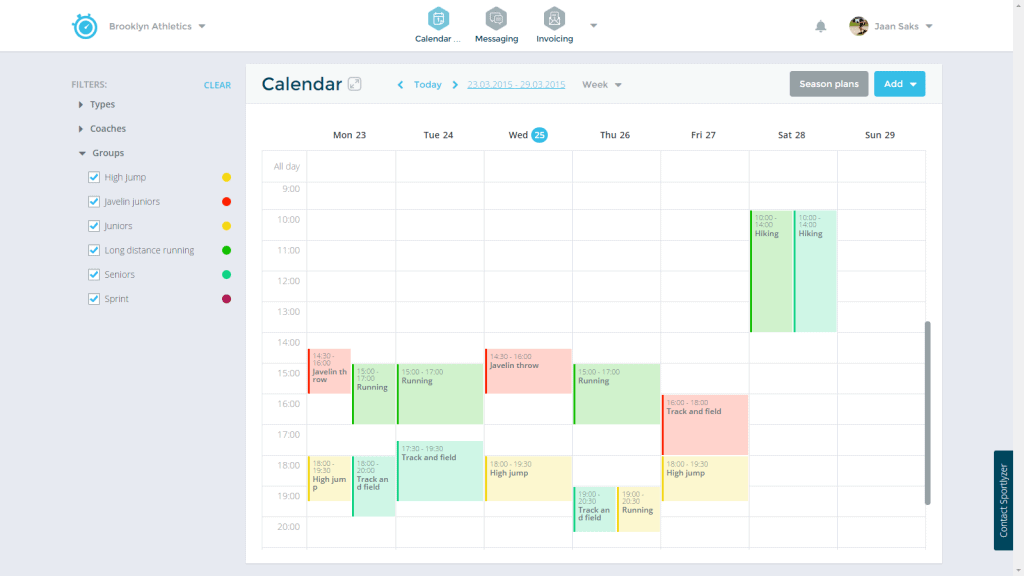How using a club calendar energizes your sports club?

A technical detail or an essential part of who you are? Like for many other businesses offering services, scheduling, and calendars are a core part of what a sports club has to offer. For the outside world, it’s a way how you establish a connection with your members and your customers. Inside a club, it’s a tool to organize your activities and manage processes. Let’s have a good hard look at the benefits a club calendar can bring to your sports club.
1. Increased attendances
Quite an obvious one, isn’t it? Yet so important for coaches. You have planned your training session beforehand to get the best results but in workout, you can’t do that drill because some people are missing. Frustrating to say the least!
When it comes to kids, it’s important to keep up with the times and communicate with them in channels that they actually use. Trusting their parents to remind them of the training schedule you sent them via e-mail some weeks ago is a slippery road to walk on. Go online and make yourself accessible to the kids and parents at any time.
Make your calendar easy to read, navigate and edit to ensure that everyone is up to date and training won’t be skipped over silly excuses like “I forgot” or “I didn’t know the time”.

2. Increasing the club spirit
For managers, it can be tricky to create a common feeling for your sports club within the club. Your club probably has different age groups, different coaches or training levels. They’re all like little islands – obviously a part of your club but maybe living their own life, slightly different from the others. The question for many sports club managers is, how to unite these islands to create unity, feeling of connection and a common spirit to fight for the same goal.
“A basketball team is like the five fingers on your hand. If you can get them all together, you have a fist. That’s how I want you to play.” – Mike Krzyzewski
Using a club calendar can come a long way to help you with that. First of all, sharing a common calendar will bring about the recognition of different training groups. Your athletes, coaches and parents will get the first glimpse of what the others are doing. It is a way to inform people what is happening in your club. Maybe another team will have an important match straight after your kids training? Why not stay and watch!
You are the same club, you wear the same colors. The first step to increase the club spirit is to actually raise awareness of each other.

3. Increased productivity due to time management
A lot of increases in efficiency and productivity come down to time management. This is true to any field of business, whether its sports, construction or retailing. How to do the most work with the least amount of time? For people working in grassroots sports, the importance of it all cannot be stressed enough as due to grassroots sports’ non-profitable nature, the area is notoriously lacking in money. This means that these passionate people working in sports are extremely overloaded.
However, all scheduling tools – whether they are your personal ones or sports club calendars – give you a better overview of what you are doing. A well-thought-out plan to manage workouts, competitions and other events will keep you on top of everything. Little things like organizing two workouts in a row or scheduling those administrative tasks for longer bus rides to competitions can help your club immensely as the true potential of your coaches and administrative staff is realized.
4. Managing facilities in the best possible way
For bigger clubs, facility and infrastructure management is an important part of the training process. If smaller clubs mainly have training sessions one after another, then the bigger ones have different training groups working at the same time.
Obviously it would be great if all the group had their own facilities but let’s be honest here, what a waste of resources would that be! The reality is that infrastructure and facilities have to be shared and the bigger the club, the bigger the headache with planning!
However, club calendar can also be used as a way to book facilities. Say you have a gym that can only fit one training group at a time and you see that two coaches have planned to have a gym session at the same time. Seeing these things beforehand from the calendar will save you from trouble and rescheduling the session will be easy.

5. Happier parents
“I’m like a taxi driver,” is probably the most used sentence of all time when two people discuss the pros and cons of being a sports parent. Can’t say I blame them, it takes a real effort to be a parent when your kid is doing sports!
For sports clubs though, parents bring in money. They are usually the ones paying for the training session or at least deciding which sports club suits their family the best. Keeping the parents happy is an ongoing process for every sports club that wants to be successful and sustainable.
While it can be hard to reduce the burden the parents have with transport issues (though carpooling is a great way to bring the club closer together!), club calendar can help the parents with scheduling and planning. An easy to read and up-to-date information is godsend for parents. These little ways of showing that the club thinks of the parents as well will be much appreciated.
6. Coaches save time for training
So as you can see, saving time is the core benefit of using a club calendar. We have seen how it can help parents and managers, but it can also help coaches. We know that most of the coaches are “in the zone” when they are actively dealing with athletes. This is where they enjoy themselves, this is what brings out the best in them. Administrative tasks are a nuisance, although necessary.
Calendars that are accessible from the web, smartphones or tablets will tackle that administrative nightmare when, for example, the time or location of the training changes. Coaches – usually being responsible to communicate the changes to athletes and parents – can quickly change the details of the training session. Athletes and their parents will see the changes in real time and coaches save time to focus on athletes.

7. Businesslike approach brings focus
I have often heard stories from club managers how disorganized their club actually is. It’s often told in a whimsical way, sometimes in a concerned manner. Deep down though, every manager should be aware of the nature of their sports clubs. As told before, sports clubs are often non-profitable in their nature and this can result in certain lack of focus. It can be unmeasurable and vague.
While the passion for sports is evident in sports clubs, it is safe to say that there are things to be learned from the business world. Adopting these practices used by “real” businesses will give your work a clear focus as you see the end goals and a roadmap to it.
8. Getting your coaches on board with further use of technology
Technology is the present and the future. We all have a smartphone in our pocket and the professional sports world is quickly adapting to this new age. We see things like video analysis, heat sensors and so on. The top of the sports pyramid has started using technology already, but due to its high cost and perceived complexity it hasn’t really reached the foundations of the sports system.
But there’s no hiding from the technology. It can be tricky at first to get coaches and athletes on board with the changes, but it is necessary to keep your club healthy and growing. Using an online club calendar is a great place to start.
The benefits of a calendar can be seen quickly – it’s comfortable, time-saving and efficient. It can be the first step in the process of adapting other proved technologies. When reluctant coaches see the first results, they are more willing to try out other new technologies as well. All aboard the tech train!

9. Increasing openness and trust in the club
We discussed before how a unified calendar can bring the club closer together. There’s another dimension to this sharing. This kind of openness always increases trust. (No, it’s not some shady relationship advice from Cosmopolitan, it really is relevant for sports clubs!)
Trust within a sports club is a tricky subject. For example, it’s normal for training groups to have different goals, but it’s not okay if they start competing for resources with each other, undermining the common goal. It’s normal to be good friends with some of your employees or coaches, but probably not normal if you start giving them preferential training times.
Without openness (for which the calendar is a start), cliques or rumors may start forming. You may think it’s silly, but it can happen unknowingly. As any doctor would say, it’s better to prevent than to treat.
10. You’ll have a clear overview of everything
For sports club managers, it can be extremely difficult to keep track on everything happening in the club. You have to deal with the business and sporting side of the club at the same time. Most likely your time is spent constantly multitasking and juggling between different activities. For example, you might be organizing a competition and preparing for a sponsor meeting at the same time.
It gets even more difficult with different training groups. Who is in a camp, who is training where? How to manage it all? It can be extremely overwhelming to keep an eye on everything but using club-wide calendars will make your life so much easier. Reduce your stress, be on top of things and keep everything under control.
And as the age-old saying goes: “Trust, but verify.”

11. Increasing the working speed of your club
This is how usually things go on if a sports club has their training schedules on their website. Let’s say a coach wants to change training times. He emails the web administrator (or simply “the IT guy” as he usually is known at the club), who most likely is not working at the club full time. If all goes well, he finds the time in a few hours to change the schedules. If not, the work will be done in a few days.
Now this is a very real situation in a sports club – the web administrator acting as a middle man takes care of the website. Imagine if coaches had an easy way to manage their calendars themselves and an effortless way to sync it with the website for the athletes and parents to see. Cutting the “IT guy” out of the equation means that changes can be made quicker and workload is reduced.

12. Managing human resources
Scenario: One of your coaches has called in sick and you need to have him replaced as soon as possible. Who’s available? What’s the most convenient way to solve the problem?
Checking the club calendar will give you a quick understanding of who’s possibly up for it and how to manage the situation. This is specially true for bigger clubs with more coaches where keeping track of everyone’s schedules can become a real task. Better management of human resources will save you and your coaches time that is so valuable at sports clubs.
13. Innovative brand image for the public
And lastly, a cool online calendar shows your skills and brand image to others. This is how the media and the public perceives you. If your website looks sleek, if you come off as an innovative club using the latest technological features, you may reap rewards in the places you least expect.
A brand image that is modern, fancy, smart and youthful is becoming more and more important to sports clubs. Whether it’s attracting new kids to your training sessions, competing with new sports like snowboarding or parkour or influencing policy makers for better decisions, a perceived brand image can do wonders for your benefit. People make important decisions based on that.
“Your brand is what people say about you when you’re not in the room” – Jeff Bezos, founder of Amazon
14. Keeping the costs under control
And finally, a calendar can help your club financially as well. This has a lot to do with a more general idea of drawing up roadmaps and plans. A well-thought-out calendar will act as a guidance tool to manage your finances. It allows you to see possible bottlenecks beforehand.
For example, for many clubs, transportation costs amount for a huge chunk of their budget. A quick glance at the calendar can help you see if your club bus is overbooked or can be booked more efficiently, reducing meaningless times spent on waiting and money spent on empty rides. It’s a simple upgrade with a long-term benefit!
So as you can see, using a club calendar has at least 14 benefits. Wow… A small step for the club but a big step for your future? Sounds about right!
Sportlyzer launched a free version of the club calendar for sports club managers and coaches a few weeks ago. Try it out yourself or read more from our blog post!
